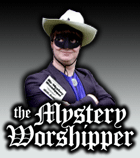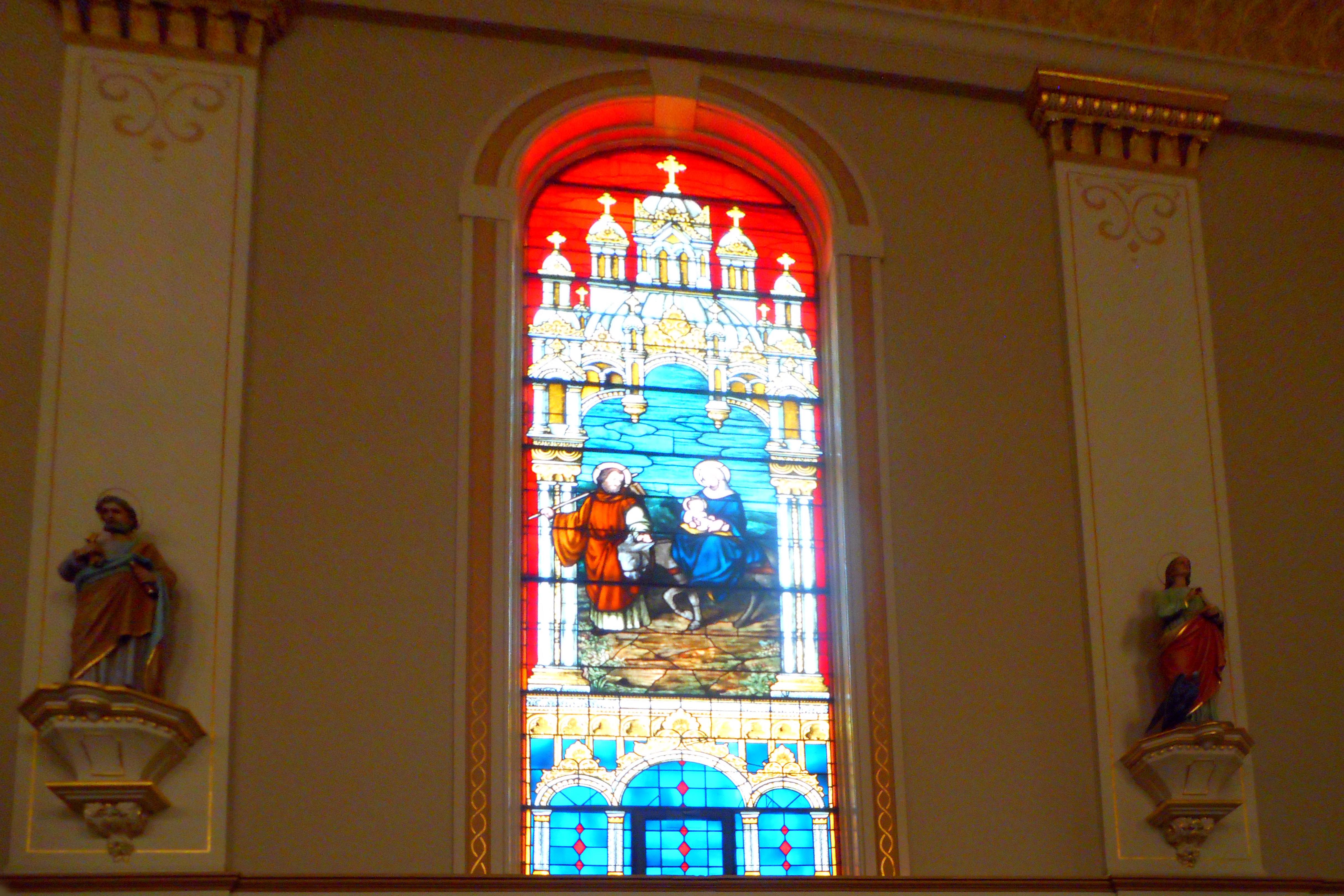| |
 |
 |
 |
| Comment on this report, or find other reports. |
 |
| Our Mystery Worshippers are volunteers who warm church pews for us around the world. If you'd like to become a Mystery Worshipper, start here. |
 |
| Find out how to reproduce this report in your church magazine or website. |
|
|
| 3301: Old St Mary's, Milwaukee, Wisconsin, USA |
 |
 |
 |
Mystery Worshipper: Paterfamilias.
The church: Old St Mary's, Milwaukee, Wisconsin, USA.
Denomination: Roman Catholic, Archdiocese of Milwaukee.
The building: Old St Mary's is Milwaukee's oldest Catholic church, constructed in 1846-47 and dedicated in 1847. Victor Schulte, a Prussian immigrant, designed Old St Mary's as well as St John's Cathedral and Holy Trinity Church. Externally, the church is in the German Neo-Classic style (Zopfstil) and has an unassuming brick exterior. There is a central tower with three bells, dating from 1868, affectionately known to parishioners as Mary, Mary Ann, and Mary Magdalene. The interior is something else, full of statuary, paintings, and stained glass. The representational stained glass windows (four on either side of the nave) are spectacular, full of bright yellows, reds, and blues; they were designed by a Munich firm, Franz Mayer Glassworks. The original altar, of hand-carved wood, is still in place. There is a beautiful painting of the Annunciation above the reredos, a gift to the parish of King Ludwig I of Bavaria. Schulte oversaw alterations to the original space in 1866-1867. The choir and organ are in a rear balcony. The building was placed on the National Register of Historic Places in 1973. A "new" St Mary's (unrelated to Old St Mary's) was built in South Milwaukee in 1893; in 2003 it merged with three other parishes to form Divine Mercy Parish.
The church: This seems to be quite an active parish, with the usual Christian formation, social, bereavement, and social justice activities, described in some detail on a well-designed website. They are clustered and share activities with three other downtown Milwaukee parishes. There are four masses each weekend.
The neighborhood: Milwaukee has a strong German heritage, evidenced by its beer and Catholic churches. Old St Mary's is right in the heart of downtown Milwaukee, surrounded by office buildings, hotels, and small businesses.
The cast: No participants were identified, except for the Revd Joe Juknialis, celebrant and homilist.
The date & time: Second Sunday of Easter and Divine Mercy Sunday, April 8, 2018, 11.30am.
What was the name of the service?
Mass.
How full was the building?
About three-quarters full; I estimate the building could hold 600-700. Lots of elderly, lots of young couples in their 20s and 30s, relatively few young children.
Did anyone welcome you personally?
No, but I arrived early to take pictures. I noticed later several ushers.
Was your pew comfortable?
Quite, with pull-down kneelers.
How would you describe the pre-service
atmosphere?
Quiet and reverent.
What were the exact opening words of the
service?
One of the lectors began with “Good morning and welcome to Old St Mary's.” He then gave a brief history of Divine Mercy Sunday. After the opening hymn, Father Joe began the mass with “He is risen! Let the church say, Alleluia!” to which the congregation responded, “Alleluia!” We then skipped the penitential rite, and went straight into the Gloria. There were several emendations to the presider's texts in the mass.
What books did the congregation use during the
service?
A 52 page booklet specially designed at Old St Mary's. It included the order of mass, a number of hymns, an order of service for a May crowning, and prayers to be said before mass. This particular booklet included hymns for April 8 through June 3 (Corpus Christi Sunday). In the order of mass, page numbers of the hymns to be sung were given for each of the Sundays this booklet was to be used. There was also a Seasonal Missalette, published by World Library Publications, that contained the readings for each Sunday.
What musical instruments were played?
Pipe organ and baby grand piano, mostly the former. The organ dates to 1894 and was expanded in 1949.
Did anything distract you?
So much more visual stimulus than in my home parish.

Was the worship stiff-upper-lip, happy clappy, or
what?
A fairly standard ordinary form, but with the freedom taken with missal texts noted above. Music was a mix of traditional (“Jesus Christ is Ris'n Today”) and contemporary (Marty Haugen's “Now We Remain”). A capable choir sang a motet (early 17th century, I would guess) as the altar was prepared. The introduction to the memorial acclamation, doxology, and Easter dismissal were chanted (Father Joe chants beautifully). Bells were rung during the institution narrative. Communion was in both kinds.
Exactly how long was the sermon?
10 minutes.
On a scale of 1-10, how good was the preacher?
9 – For the cockroaches (see below). Take the cockroaches out, and he's a solid 10. Father Joe is a very charismatic speaker. He spoke without notes.
In a nutshell, what was the sermon
about?
Humans are curious: they want inner peace but live with all kinds of fears. The disciples met behind closed doors; they were afraid. We can become paralyzed by our fears, both personal and societal. Jesus comes into that fear and says, “Peace” (the gospel was John 20:19-31, Jesus appears to the disciples when Thomas is absent, then to the disciples and Thomas a week later). In the epistle (1 John 5:1-6) we read “Who, then, is the conqueror of the world? The one who believes that Jesus is the Son of God.” But we often don't feel like conquerors over the world. How can we deal with our fears? The first reading (Acts 4:32-35, describing the early Christian community – “nor was there anyone needy among them”) shows one way: the early Christians focused on the community, and not on themselves. If I focus on other people, I don't worry about me. Father Joe then went into a brief digression about cockroaches. With quite a bit of construction going on in the area around St Mary's, some of the foundations in the rectory's basement were shifting, bringing cockroaches in. But cockroaches are nocturnal, so the priests in the rectory brought in bright lights and left them on all night. The cockroaches are still there, but the priests don't see them. Then he noted that the gospel shows another way of finding peace: being a part of a faith community. Thomas may have had his doubts, but he remained a part of the community.
Which part of the service was like being in
heaven?
The stained glass.
And which part was like being in... er... the other place?
The cockroaches. First of all, I would very much prefer not to be reminded of their existence. Second, I didn't quite catch the relevance of the cockroaches to the rest of the excellent homily.
What happened when you hung around after the service looking lost?
Nothing. I will give this congregation credit: they sang well, and we sang all of the verses of the closing hymn with very few early departures. But as soon as the final hymn was over, folks made their way out fairly quickly.
How would you describe the after-service
coffee?
There was none.
How would you feel about making this church your regular (where 10 = ecstatic, 0 = terminal)?
9 – If we moved to Milwaukee, it would be a place to start. There are a lot of options in the city.
Did the service make you feel glad to be a
Christian?
Yes.

What one thing will you remember about all this in seven days' time?
The hand-carved altar, and the stained glass. |
|
|
 |
 |
 |
| We rely on voluntary donations to stay online. If you're a regular visitor to Ship of Fools, please consider supporting us. |
 |
 |
 |
| The Mystery Pilgrim |
 |
| One of our most seasoned reporters makes the Camino pilgrimage to Santiago de Compostela in Spain. Read here. |
 |
 |
 |
| London churches |
 |
| Read reports from 70 London churches, visited by a small army of Mystery Worshippers on one single Sunday. Read here. |
| |
|
|
|
|


